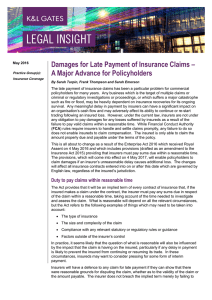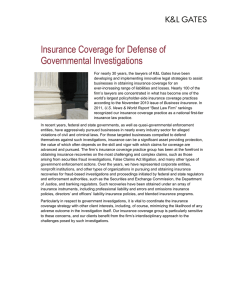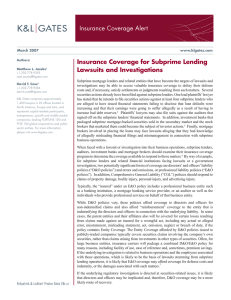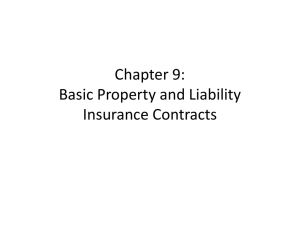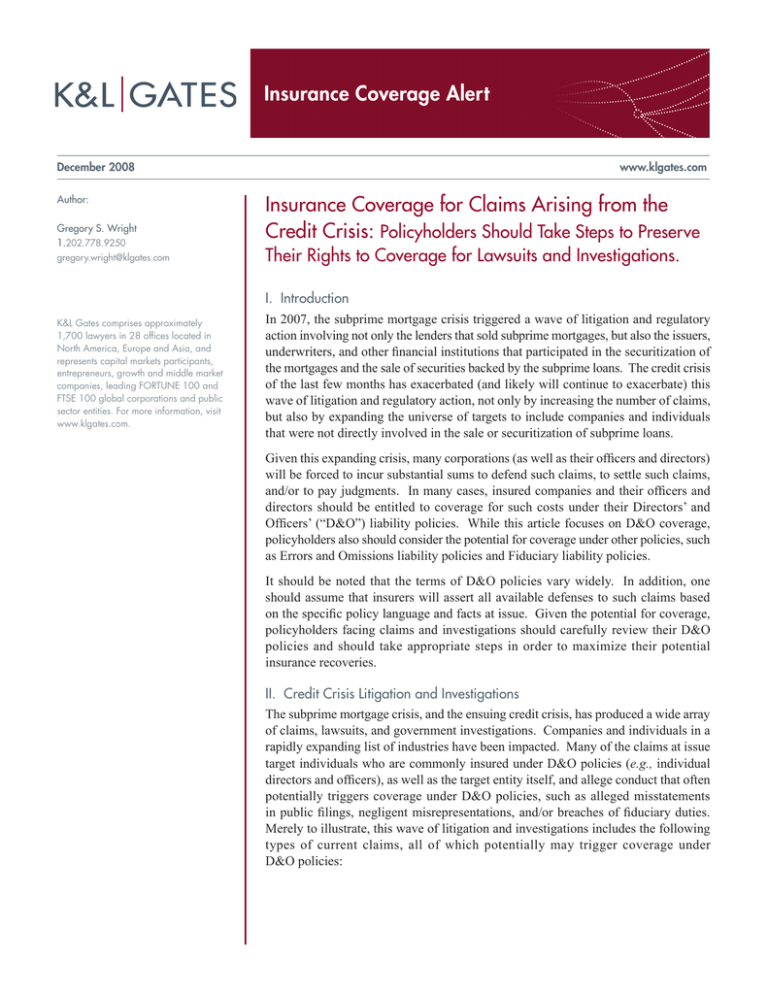
Insurance Coverage Alert
December 2008
Author:
Gregory S. Wright
1.202.778.9250
gregory.wright@klgates.com
K&L Gates comprises approximately
1,700 lawyers in 28 offices located in
North America, Europe and Asia, and
represents capital markets participants,
entrepreneurs, growth and middle market
companies, leading FORTUNE 100 and
FTSE 100 global corporations and public
sector entities. For more information, visit
www.klgates.com.
www.klgates.com
Insurance Coverage for Claims Arising from the
Credit Crisis: Policyholders Should Take Steps to Preserve
Their Rights to Coverage for Lawsuits and Investigations.
I. Introduction
In 2007, the subprime mortgage crisis triggered a wave of litigation and regulatory
action involving not only the lenders that sold subprime mortgages, but also the issuers,
underwriters, and other financial institutions that participated in the securitization of
the mortgages and the sale of securities backed by the subprime loans. The credit crisis
of the last few months has exacerbated (and likely will continue to exacerbate) this
wave of litigation and regulatory action, not only by increasing the number of claims,
but also by expanding the universe of targets to include companies and individuals
that were not directly involved in the sale or securitization of subprime loans.
Given this expanding crisis, many corporations (as well as their officers and directors)
will be forced to incur substantial sums to defend such claims, to settle such claims,
and/or to pay judgments. In many cases, insured companies and their officers and
directors should be entitled to coverage for such costs under their Directors’ and
Officers’ (“D&O”) liability policies. While this article focuses on D&O coverage,
policyholders also should consider the potential for coverage under other policies, such
as Errors and Omissions liability policies and Fiduciary liability policies.
It should be noted that the terms of D&O policies vary widely. In addition, one
should assume that insurers will assert all available defenses to such claims based
on the specific policy language and facts at issue. Given the potential for coverage,
policyholders facing claims and investigations should carefully review their D&O
policies and should take appropriate steps in order to maximize their potential
insurance recoveries.
II. Credit Crisis Litigation and Investigations
The subprime mortgage crisis, and the ensuing credit crisis, has produced a wide array
of claims, lawsuits, and government investigations. Companies and individuals in a
rapidly expanding list of industries have been impacted. Many of the claims at issue
target individuals who are commonly insured under D&O policies (e.g., individual
directors and officers), as well as the target entity itself, and allege conduct that often
potentially triggers coverage under D&O policies, such as alleged misstatements
in public filings, negligent misrepresentations, and/or breaches of fiduciary duties.
Merely to illustrate, this wave of litigation and investigations includes the following
types of current claims, all of which potentially may trigger coverage under
D&O policies:
Insurance Coverage Alert
• Lawsuits by shareholders against lenders and
certain directors and officers alleging (in part) that
defendants made false and misleading statements
to the public about subprime lending activities.
• L awsuits by shareholders against investment
banks and certain directors and officers alleging
misstatements about the value of and risks
associated with subprime-backed assets.
• Lawsuits by investors against financial institutions
and certain directors and officers alleging that
the defendants that sold them mortgage-backed
securities misrepresented the risks associated with
such securities.
• Class action lawsuits against failed banks, related
holding companies, and related officers and
directors, alleging that the defendants misled
investors about the financial status of the bank,
violated securities laws, committed fraud, made
negligent misrepresentations, etc.
• C lass action lawsuits on behalf of certain
institutions alleging false statements by named
officers and directors in connection with the
offerings.
• C lass action lawsuits against companies not
directly involved in the subprime area as well as
their directors and officers, alleging failure to make
appropriate disclosures about exposures arising
from credit problems of trading partners.
• Class action lawsuits and regulatory investigations
against companies concerning auction rate
securities. The lawsuits allege in general that the
companies failed to make appropriate disclosures
about the risks associated with auction rate
securities. Some (but not all) of the lawsuits
name individual directors and officers. While
most of the lawsuits have been filed on behalf of
the purchasers of the auction rate securities, at least
one lawsuit was filed on behalf of shareholders of
the entity that sold the auction rate securities to
other investors. See also M. King, SEC and FINRA
Focusing on Individuals in Auction Rate Securities
Investigation, available at http://www.klgates.com/
newsstand/Detail.aspx?publication=4966.
• S EC investigations into possible market
manipulation in connection with short selling
in the securities of financial institutions. See
B. Ochs, Manipulation Tied to Short Selling
a Top Enforcement Priority, available at
http://www.klgates.com/newsstand/Detail.
aspx?publication=4966.
• FBI and DOJ criminal investigations regarding
accounting, disclosure, and corporate governance
matters. See M. Ricciuti, DOJ Opens Criminal
Investigations under New Guidelines for
Prosecuting Corporate Entities, available at
http://www.klgates.com/newsstand/Detail.
aspx?publication=4966.
III. Potential Coverage under D&O Policies
In general, D&O policies afford coverage for
“Claims” against an “Insured” alleging “Wrongful
Acts” that result in a covered “Loss.” The
availability of coverage turns on the definitions
of such terms (which vary widely), other policy
terms and conditions, and the nature of the specific
allegations in the claim at issue.
Claim. D&O policies generally afford coverage for
“claims.” All (or virtually all) D&O policies include
“lawsuits” within the definition of “claim,” but
coverage for regulatory or criminal investigations
varies widely. For example, certain D&O policies
define “claim” to include SEC investigations
commenced by the service of a subpoena on an
insured person or criminal proceedings commenced
by the return of an indictment, information, or similar
document. Other D&O policies cover a broader
array of informal investigations, while other policies
limit coverage to investigations commenced by a
“formal order” of investigation. In any event, given
the broad array of policy language available in the
market, insureds should not wait for lawsuits to be
filed before analyzing the potential for coverage.
Entity Coverage. In addition to covering claims
against insured directors and officers, many D&O
policies afford coverage for claims against the
insured entity itself (for example, many D&O
policies cover so-called “Securities Claims” filed
against the insured entity, including class action
December 2008 | 2
Insurance Coverage Alert
securities lawsuits). The inclusion of “entity
coverage” in D&O policies often helps insurers
and policyholders avoid disputes on how to allocate
defense costs and/or settlement payments among
covered individuals and the entity itself.
Loss. The definition of “loss” in D&O policies
varies widely. For example, some policies expressly
cover fines, penalties, multiplied damages, and
punitive damages, when permitted by law. Some
D&O policies do not. In addition, insurers and
policyholders frequently litigate (and courts recently
have reached conflicting opinions on) the availability
of coverage for so-called “disgorgement,”
“restitution,” and/or for losses paid pursuant to
Section 11 of the Securities Act of 1933. See, e.g.,
Bank of America Corp. v. SR International Business
Ins. Co., 2007 WL 4480057 (N.C. Super. 2007)
(holding that settlement of Section 11 claim may be
covered under D&O policy).
Conduct Exclusions. Insurers also may seek to
rely on various exclusions in the relevant policy
to deny coverage for subprime-related claims. For
example, insurers may seek to rely on so-called
conduct exclusions, which bar coverage for certain
claims relating to criminal or fraudulent activity
or for claims alleging that the insured received a
profit to which he or she was not legally entitled.
Again, it should be noted that the terms of these
exclusions vary widely. Some exclusions arguably
bar coverage when the excluded conduct is merely
alleged. However, in most policies, the exclusions
do not apply unless the insurer meets its burden of
proving that the excluded conduct “in fact” occurred
or unless the excluded conduct is established via
a “final adjudication.” When the policy at issue
includes the “in fact” test or “final adjudication” test,
insureds are often entitled to coverage for defense
costs and/or settlements that are made without any
finding or admission with respect to the excluded
conduct. In addition, many D&O policies contain
severability provisions that prevent the insurer from
imputing the knowledge or conduct of one insured
to other insureds, which in effect preserves coverage
for the “innocent insureds” and/or the company
itself.
Defense Issues. In many D&O policies, the insurer
is not obligated to defend a claim, but rather is
required to reimburse the policyholder’s defense
costs. Nevertheless, certain D&O policies state
that the policyholder should not incur defense
costs or settle a claim without the consent of the
insurer. In addition, certain D&O policies require
the policyholder to obtain the insurer’s consent with
respect to the selection of defense counsel (such
consent not to be unreasonably withheld). To avoid
potential insurer defenses, policyholders may wish
to consider taking steps to address any conditions
in the policy related to defense and/or cooperation
with the insurer.
Rescission Issues. In response to claims alleging
misleading statements in a public filing, insurers
often attempt to rescind the policy at issue entirely
to the extent the public filing at issue was attached
to or incorporated by reference into the insured’s
“application” for coverage. State law on this
defense varies widely, but most courts impose a high
burden of proof on insurers to demonstrate (among
other things) that the alleged misrepresentation was
material and that the insurer in fact relied on the
alleged misrepresentation when it decided to issue
the policy. In addition, many current D&O policies
make coverage non-rescindable for certain types
of claims or certain insureds. Further, many D&O
policies contain strict severability clauses that limit
the insurer’s right to rescind to only those individuals
that had specific knowledge of the misstated facts.
Renewal Issues. As noted above, the terms of
D&O policies vary widely. Further, insureds
and insurers frequently negotiate certain terms of
coverage during the renewal process. With proper
planning, insureds potentially may obtain coverageenhancing changes to standard policy forms that
may be outcome-determinative when a claim is
filed. Insureds frequently retain outside coverage
counsel to review their D&O policies and participate
in this renewal process.
December 2008 | 3
Insurance Coverage Alert
IV. Conclusion
D&O policies offer a potentially valuable
resource for policyholders facing claims arising
from the subprime crisis and related credit crisis.
Policyholders should take steps now to preserve
their rights to coverage.
K&L Gates comprises multiple affiliated partnerships: a limited liability partnership with the full name K&L Gates LLP qualified in Delaware and
maintaining offices throughout the U.S., in Berlin, in Beijing (K&L Gates LLP Beijing Representative Office), and in Shanghai (K&L Gates LLP
Shanghai Representative Office); a limited liability partnership (also named K&L Gates LLP) incorporated in England and maintaining our
London and Paris offices; a Taiwan general partnership (K&L Gates) which practices from our Taipei office; and a Hong Kong general
partnership (K&L Gates, Solicitors) which practices from our Hong Kong office. K&L Gates maintains appropriate registrations in the
jurisdictions in which its offices are located. A list of the partners in each entity is available for inspection at any K&L Gates office.
This publication is for informational purposes and does not contain or convey legal advice. The information herein should not be used or
relied upon in regard to any particular facts or circumstances without first consulting a lawyer.
©1996-2008 K&L Gates LLP. All Rights Reserved.
December 2008 | 4


